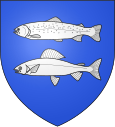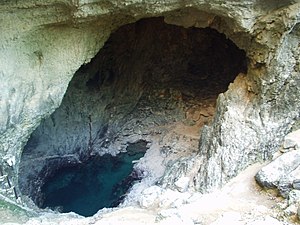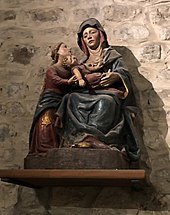Fontaine-de-Vaucluse
| Fontaine-de-Vaucluse | ||
|---|---|---|

|
|
|
| region | Provence-Alpes-Cote d'Azur | |
| Department | Vaucluse | |
| Arrondissement | Avignon | |
| Canton | L'Isle-sur-la-Sorgue | |
| Community association | Pays des Sorgues et des Monts de Vaucluse | |
| Coordinates | 43 ° 55 ' N , 5 ° 8' E | |
| height | 68-652 m | |
| surface | 7.14 km 2 | |
| Residents | 604 (January 1, 2017) | |
| Population density | 85 inhabitants / km 2 | |
| Post Code | 84800 | |
| INSEE code | 84139 | |
 Sorgue spring pond when the water level is very low |
||
Fontaine-de-Vaucluse is a French municipality with 604 inhabitants (at January 1, 2017) in the department of Vaucluse in the region Provence-Alpes-Cote d'Azur . Its original name was "Vaucluse" ( vallis clausa , Latin : closed valley) until 1946 . The Vaucluse department was named after the municipality in 1793. It belongs to the canton of L'Isle-sur-la-Sorgue in the Arrondissement of Avignon .
Population development
| year | 1962 | 1968 | 1975 | 1982 | 1990 | 1999 | 2007 | 2017 |
|---|---|---|---|---|---|---|---|---|
| Residents | 781 | 698 | 532 | 604 | 580 | 610 | 681 | 604 |
Sources: Cassini and INSEE
Attractions
In addition to Roman artefacts from the 4th, the castle ruins on a rock above the village from the 7th and various medieval buildings and the Notre-Dame et Saint Véran church from the 11th century, the place is characterized primarily as the former residence of the Italian poet Petrarch , who is said to have written a large part of his poems here in a kind of self-chosen exile . The building, which still exists today, is now a museum and - together with the spring grotto impressively described by Petrarch - attracts numerous visitors every year. Since Vaucluse was the center of the regional paper industry until the beginning of the 18th century, the last remaining paper mill on the banks of the Sorgue was converted into a much-visited museum and center for handicrafts and art in 1974 .
church
The Saint-Véran church was built in the 11th century on the site of an old water sanctuary and a Carolingian building with the tomb of St. Véran . Some elements were reused, such as the fragments of the choir from the 8th century and an altar carved into a tomb slab from the 1st century in the 6th century, and the sarcophagus of St. Véran from the 6th century. The church has a transept , a rather rare feature in Provence. The font dates from the 12th century. Above the entrance is a copy of a painting by Nicolas Mignard , on which Saint Véran is depicted conquering a monster. An illustration of Anna Selbdritt from the 15th century , polychromed from wood. The altarpiece with the Descent from the Cross was donated by the confrérie des papetiers in 1654 . In 1804 a memorial column in honor of Petarca was erected in the church square at the end of the bridge.
Museums
- Musée-Bibliothèque François-Pétrarque
The Petrarca Museum was founded in 1927 and follows on from the Petrarkist tradition and the interest in Italian studies, which were brought back to the fore by the romantic aesthetics . It includes drawings and prints by Petrarch, Laura , Avignon and the Sorgue source, as well as a collection of old editions of Petarca and French and Italian Petrar boxes, which is supplemented by a specialist library. A small collection of modern art shows works by famous artists such as Georges Braque , Alberto Giacometti , Joan Miró , Zao Wou-Ki and Pablo Picasso , which are related to the poems and writings of René Char .
- Musée du Santon et Traditions de Provence
In the center of the village, the museum shows a collection of 2000 santons and more than 50 nativity scenes , including a miniature made from a walnut shell . These works come from around a hundred Santon makers in the region.
- Musée d'Histoire 1939–1945 "l'Appel de la Liberté"
The museum is dedicated to the period from 1939 to 1945. A collection of posters and objects thematize everyday life, opposing ideologies and voluntary collaboration . The Resistance in Vaucluse is examined in more detail with regard to its organization, its networks, its actions and events. A section includes secret, censored or foreign publications, militant magazines, manuscripts by René Char, François Mauriac or Max Jacob, and original works by Henri Matisse , Joan Miró and Pablo Picasso. The museum also houses a documentation and research center dedicated to the two world wars and the war of 1870, as well as the literary and artistic activity of those times.
- Le Monde Souterrain de Norbert Casteret
The museum is named after Norbert Casteret , a pioneer of modern speleology . In addition to an exhibition on cave equipment, it includes replicas of various caves and grottos and an extensive collection of crystalline rocks that Norbert Casteret himself collected.
Source of Sorgue
The main attraction of the place is the source of the Sorgue at the foot of a 230 meter high rock wall, which feeds the river at up to 22 m³ per second when the snow melts . The water level varies greatly depending on the season and the amount of rain . In dry periods, a large part of the above-ground basin lies dry, the river then only emerges a few hundred meters below the surface. The French diver and marine researcher Jacques-Yves Cousteau and his team were the first to systematically research the subterranean cave and spring system in various dives.
However, the origin of the spring was not finally clarified until 1985 with the help of a diving robot : The deepest point of the siphon is 308 meters deep. The spring cave is the deepest on earth. It is the outflow of an underground basin of 1,100 km² that receives the waters of Mont Ventoux , Monts de Vaucluse and Montagne de Lure .
Web links
- Fontaine de Vaucluse at the Office du Tourisme Intercommunal
- Description of the spring with a history of the exploration of the karst cave from which the spring water of the Sorgue flows here ( Memento from January 11, 2013 in the Internet Archive )
- Joseph Viktor von Scheffel : At the source of Vaucluse (sonnet), published in: Gedichte aus dem Nachlaß , 5th edition, Stuttgart 1889, p. 75
- Goepfert & Goepfert (1988) Fontaine de Vaucluse - exploring the source. Editions Aio, Le Cannet, 35 p. (Pdf 19MB)
Individual evidence
- ^ Jean Bonnet et al .: Notre-Dame-Saint Veran Fontaine-de-Vaucluse . Imprimierte Beau Lieu, Lyon, S. 8; 12 .
- ↑ a b c d e Michel Albarède et al .: Vaucluse (= Encyclopédies du Voyage ). Gallimard Loisirs, Paris 2007, ISBN 2-7424-1900-4 , p. 323-325 .
- ↑ Author collective Brockhaus: Vaucluse . In: FA Brockhaus (Ed.): Brockhaus Enzyklopädie . 18th edition. tape 23 . FA Brockhaus GmbH, Mannheim 1994, ISBN 3-7653-1123-5 , p. 79 .



